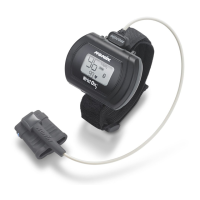2
Indications for Use
Cautions
If this device fails to respond as described, refer to “Troubleshooting” or discontinue use until the situation has been
corrected. Contact Nonin Technical Service.
This device has motion tolerant software that minimizes the likelihood of motion artifact being misinterpreted as
good pulse quality. In some circumstances, however, the device may still interpret motion as good pulse quality.
Check the pulse oximeter sensor application site every 6-8 hours to determine the positioning of the sensor and the
circulation and skin sensitivity of the patient. Patient sensitivity varies depending on medical status or skin condition.
Do not place liquids on top of this device.
Do not place the WristOx
2
, Model 3150, in liquid or clean it with agents containing ammonium chloride or isopropyl
alcohol. Refer to the “Care and Maintenance” section of this operator’s manual.
Use a detergent that is safe for skin and washable surfaces. Most detergents can be high sudsing, so use sparingly.
Wipe with a damp, detergent free cloth to remove residue.
Follow local, state, and national governing ordinances and recycling instructions regarding disposal or recycling of
the device and device components, including batteries.
In compliance with the European Directive on Waste Electrical and Electronic Equipment (WEEE) 2002/96/EC, do
not dispose of this product as unsorted municipal waste. This device contains WEEE materials; please contact your
distributor regarding take-back or recycling of the device. If you are unsure how to reach your distributor, please call
Nonin for your distributor’s contact information.
This device is designed to determine the percentage of arterial oxygen saturation of functional hemoglobin. Factors
that may degrade pulse oximeter performance or affect the accuracy of the measurement include the following:
• excessive ambient light
• excessive motion
• electrosurgical interference
• blood flow restrictors (arterial catheters,
blood pressure cuffs, infusion lines, etc.)
• moisture in the sensor
• improperly applied sensor
• incorrect sensor type
Do not perform any testing or maintenance on this device while it is being used to monitor a patient.
Verify all visible indicators appear during the start-up (initialization) sequence. If any indicator does not appear, do
not use the device. Contact Nonin Technical Service for assistance.
Portable and mobile RF communications equipment can affect medical electrical equipment.
Batteries may leak or explode if used or disposed of improperly. Remove batteries if the device will be stored for
more than 30 days. Do not use different types of batteries at the same time. Do not mix fully charged and partially
charged batteries at the same time. These actions may cause the batteries to leak.
To avoid the risk of confusing or misinterpreting patient data when transmitting data via Bluetooth, verify the device
is paired with the correct display unit.
The pulse oximeter may not work when circulation is reduced. Warm or rub the finger or reposition the sensor.
A functional tester cannot be used to assess the accuracy of the oximeter or sensor.
Do not fasten the device too tightly around the patient’s wrist. Inaccurate readings and patient discomfort could
result.
• poor pulse quality
• venous pulsations
• anemia or low hemoglobin concentrations
• cardiogreen and other intravascular dyes
• carboxyhemoglobin
• methemoglobin
• dysfunctional hemoglobin
• artificial nails or fingernail polish

